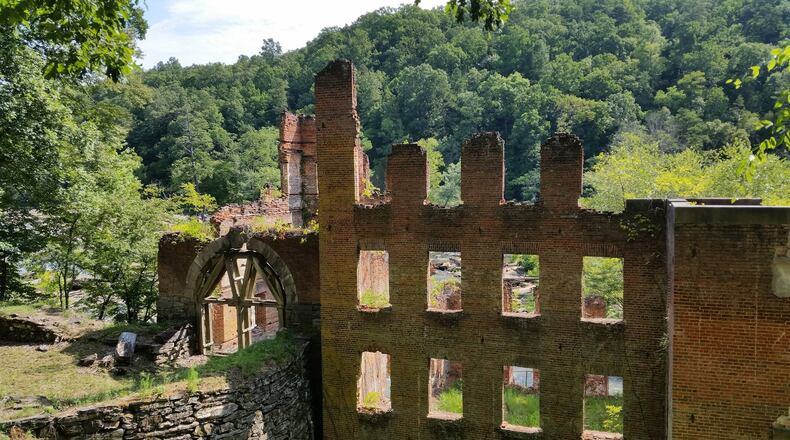Tucked away on an old trail once frequented by Native Americans and pioneers sits a piece of Georgia history established more than a decade before the Civil War.
The Sweetwater Creek/New Manchester Manufacturing Co. mill in Douglas County had more than 100 employees at one time, and it was taller than any building in Atlanta when it first opened in 1849. But despite a relatively remote location, it didn’t escape Gen. William T. Sherman’s troops during the War between the States and was burned after capture on July 2, 1864, leaving a set of ruins visited by curious locals ever since.
Those tours were halted two years ago when structural erosion left the area too dangerous to enter. This summer, the ruins are being carefully restored to ensure the site’s future as a historic destination.
"Knowing that our visitors aren't able to come in here and see this mill up close and personal is difficult," said David Jordan, park manager at Sweetwater Creek State Park. "We're hoping that after they get finished, we can have photographers back in here, weddings back in here and, of course, movies back in here."
Once the mill reopens in the fall (October is the current goal), it will resume all of those functions, including as a high-profile filming site. The mill has already served as a backdrop for movies including 2014's "The Hunger Games: Mockingjay — Part 1," which featured Jennifer Lawrence as Katniss inside the mill.
History on Sweetwater Creek
Built in the late 1840s, the mill predates Douglas County itself and was financed by some of Georgia’s most prominent citizens of the day. Investors included former Georgia Gov. Charles McDonald and a man named William John Russell, the grandfather of famed U.S. Sen. Richard B. Russell Jr. of Georgia.
The mill is an engineering feat. Built mostly by slave labor, it involved the construction of a large millrace to channel water from Sweetwater Creek through a 45,000-pound, 16-foot-long wheel that powered the mill’s operations. Each of the five floors specialized in part of the process of making yarn or osnaburg cloth.
Initially known as the Sweetwater Village mill, in 1857 it was renamed New Manchester Manufacturing Co., after the city of Manchester, England. About 100 workers lived on-site in a small town centered around the textile operations and shopped at the company store. While some may consider it strange that weddings are held at such a historic place today, there is some evidence weddings were held there even during its operations, according to Douglas County historian and author Lisa Cooper.
“Even today you can tell how massive the mill was during its heyday. At five stories tall, the mill was the largest manufacturing site north of Macon,” Cooper said. “The mill building not only served as a workplace, but a social center for the village.”
The mill was enormously profitable during the 1850s, and initially became even more so due to the war. According to Cooper’s research, mill owners pumped $15,000 into the textile business for new machinery and buildings in 1860, and reaped rewards in the form of a $24,902 order from the Confederate States Army.
“They were aware of the huge potential regarding the rushing waters of Sweetwater Creek,” Cooper said. “It was said to be one of the best sources for water power in this section of the state mainly due to the interesting topography along the Brevard Fault.”
But in the end, the mill burned with the rest of Atlanta, and the women and children who worked there were arrested and sent to Marietta. Many were later shipped to Louisville, Ky., and left to fend for themselves.
Following the war, it was decided not to rebuild the facility, leaving the town of New Manchester as only a memory, along with famous ruins that visitors see today.
Restoration process
Aegis Restauro LLC is leading the $375,000 project, which aims to stabilize the property. With an estimated 800,000 annual visitors to Sweetwater Creek State Park, the work includes steel rods, new mortar and concrete caps with the aim of keeping the site safe and tour-ready for decades.
The building has seen its share of abuse. For example, it has long been ridden with bullet holes, but none stem from a Civil War battle.
“There was really not a Confederate presence at Sweetwater Creek State Park,” said Jordan, the park manager. “It was the Union Army that was here. All the local men had already left and went to war.”
Instead, most bullet holes came from the guns of locals using the site as an easy shot for target practice before the state park was established. Sweetwater Creek State Park opened in 1976 but was established several years earlier.
The holes are far from the only scar on the ruins, as still visible are warped bricks from the heat of the fire in 1864.
The mill also features architectural points typical of its place and time. For example, the windows were cut at angles to allow for more natural light as there were no light bulbs, and dust from the materials made candle light unusable.
“From our modern perspective, it’s hard to imagine how something this significant could even operate,” Jordan said. “When this was built, it was the tallest structure in the skyline of Atlanta.”
About the Author
Keep Reading
The Latest
Featured



